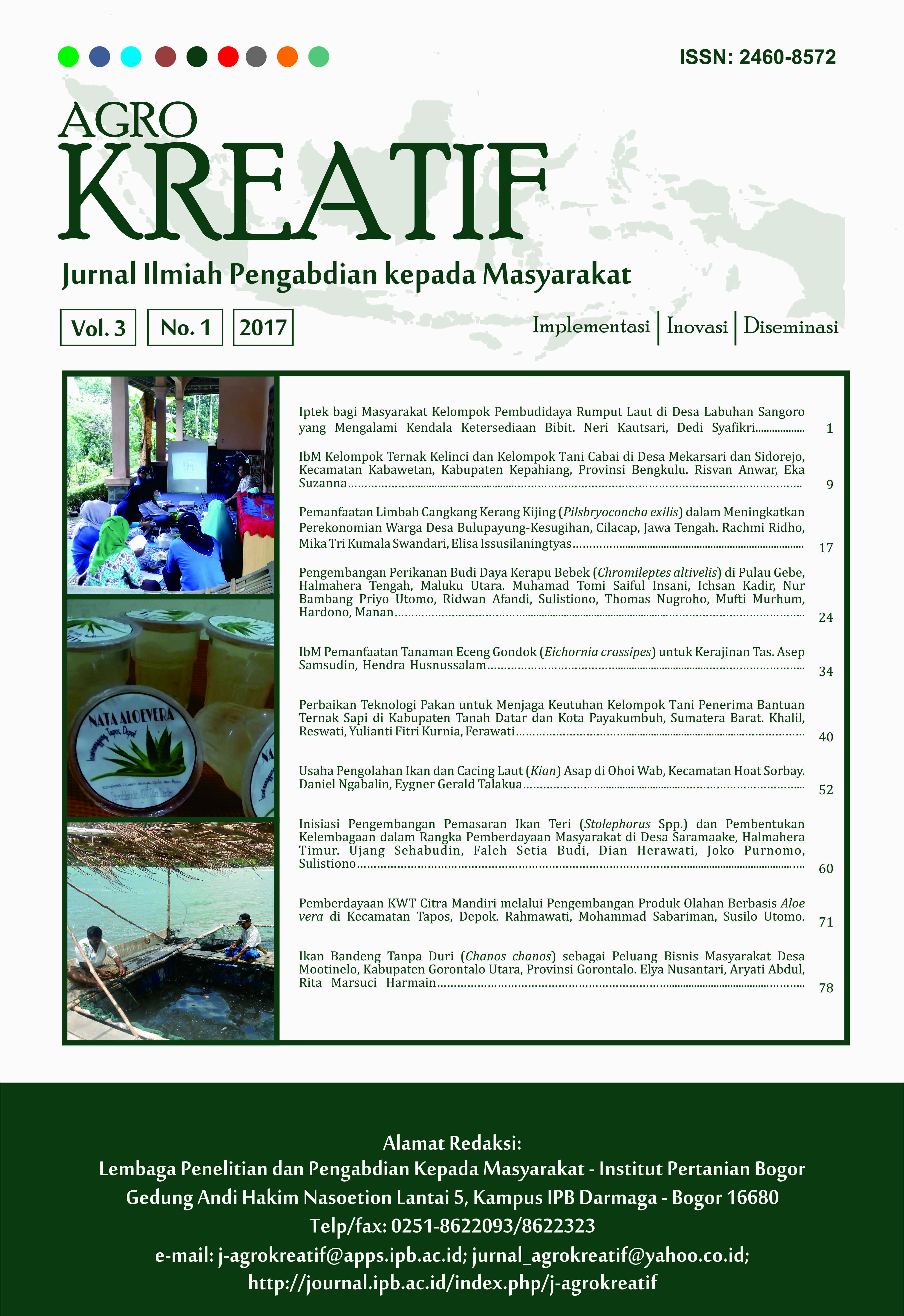Ikan Bandeng Tanpa Duri (Chanos chanos) sebagai Peluang Bisnis Masyarakat Desa Mootinelo, Kabupaten Gorontalo Utara, Provinsi Gorontalo
Abstract
One of the problems of the fishing community of milkfish (Chanos chanos) Mootinelo Village, North Gorontalo District was the selling price of fish is cheap. That was because the milkfish has many thorns so that less favored communities. However, milkfish has a high excess nutrients especially unsaturated fatty acids omega-3 (ω3) reached 14.2 and a protein content of 20. In relation with it, this activity aims to increase the sale value of milkfish through training activities thorn fish and diversified products. The method used was the training activities thorn fish, dan accompaniment of activities to pull out the fish milk spines to produce diversification products, followed by mentoring partner groups, especially women and households, as well as the surrounding communities who have the desire to entrepreneurship. The activities were practiced partner groups thorn fish suit the morphology and position structure thorns fish. The result was a fish without spines can be sold to consumers or processed into products, such as nuggets, meatballs, krispy milkfish, and a traditional menu of Gorontalo fish area such as rica-rica and woku fish. The conclusion is milkfish without spines have a profitable business opportunity with the increase in the selling price of milkfish without spines. It can increase the income of fishing communities in the fish ponds in the Mootinelo Village, North Gorontalo District.Downloads
References
Afrianto E, Evi L. 2011. Pengawetan Dan Pengolahan Ikan. Yogyakarta (ID): Kanisius.
Balai Pengembangan dan Pengujian Mutu Hasil Perikanan. 2004. Ikan bandeng dan Produk Diversifikasinya. Jakarta (ID): Departemen Kelautan dan Perikanan.
Bank Indonesia. 2008. Pola Pembiayaan Usaha Kecil bandeng Tanpa Duri. Tim Penelitian dan Pengembangan Perkreditan & UMKM. Jakarta (ID).
Oktavianti D. 2016. Pengaruh Filtrat Bawang Putih (Allium Sativum Linn.) Terhadap Jumlah Koloni Bakteri Pada Fillet Ikan Bandeng (Chanos chanos Forsk). Dalam: Prosiding Seminar Nasional II Tahun 2016, Kerjasama Prodi Pendidikan Biologi FKIP Dengan Pusat Studi Lingkungan dan Kependudukan (PSLK) Universitas Muhammadiyah Malang. Malang (ID): 26 Maret 2016.
Rofik S, Rita DR. 2012. Ekstrak Daun Api-Api (Avecennia marina) Untuk Pembuatan Bioformalin Sebagai Antibakteri Ikan Segar. Dalam: Prosiding SNST ke-3 Tahun 2012. Semarang (ID): Universitas Wahid Hasyim.
Saparinto C. 2009. Bandeng Tanpa Duri dan Cara Pengolahannya. Semarang (ID): Dahara Prize.
Saparinto C. 2007. Membuat Aneka Olahan Bandeng. Jakarta (ID): Penebar Swadaya.
Susilowati A, Reskiati. 2015. Efektivitas Penetrasi Bawang Putih (Allium Sativum Linn.) Dan Kunyit (Curcuma Domestica Val) Terhadap Kadar Air Ikan Bandeng (Chanos chanos Forsk.) Duri Lunak. Jurnal Balik Diwa. 6 (2): 20-25.
Vatria B. 2010. Pengolahan Ikan Bandeng (Chanos chanos) Tanpa Duri. Jurnal Ilmu Pengetahuan dan Rekayasa. Januari 2010: 18-23.
Waridi. 2004. Pengolahan Bakso Ikan. Jakarta (ID): Departemen Pendidikan Nasional Direktorat Jenderal Pendidikan Dasar Dan Menengah Kejuruan.
Winarno FG. 1993. Pangan: Gizi, Teknologi dan Konsumen. Jakarta (ID): Gramedia Pustaka Utama.
Yuyun A. 2014. Membuat Lauk Crispy. Jakarta (ID): Agromedia Pustaka.
This work is licensed under a Creative Commons Attribution-NonCommercial 4.0 International License.



















